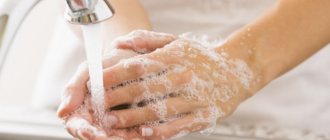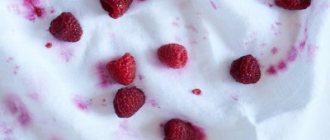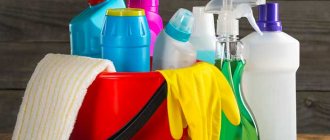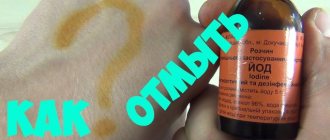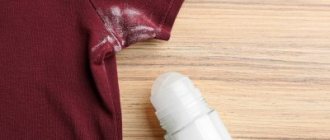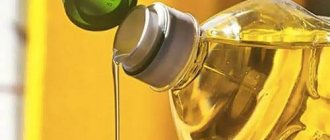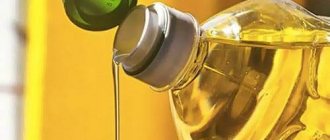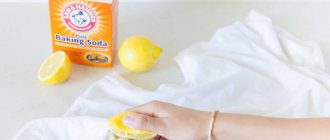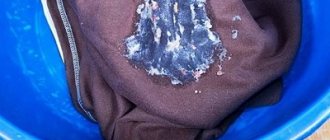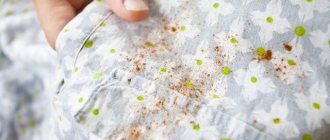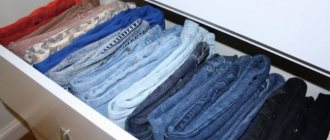Before any washing, it is always recommended to sort your items. This rule also applies to colored clothing.
To wash it, you should select special products. It is recommended to wash colored items according to the instructions.
Let's take a closer look at this process: how to wash colored items at home in a washing machine and by hand, at what temperature.
Possibility of joint processing
Not all colored fabrics can be washed together. It is important to consider two nuances. The first is the combination of colors of things, the second is the combination of materials from which they are made.
Products of different colors with each other
When washing several colored items, it is recommended to follow these rules:
You can wash items of similar color shades together. This applies to the combination of blue and green clothes, yellow and orange, red and pink.- You cannot put clothes made from contrasting fabrics together in the machine or wash them by hand. This applies to yellow and blue clothes, green and red, blue and orange, gray and orange, blue and pink.
- You can wash colored items made from the same or matching fabrics together. This applies to items made of cotton, linen, chintz and calico. It is allowed to put colored synthetic items in the wash together. It is permissible to wash cashmere and wool clothes together. You can combine clothes made of silk with synthetics.
- You cannot wash colored linen and cotton linen with synthetics together. This also applies to items made of wool and cotton, wool and linen.
Even if two items are the same color but made from different materials, they should not be washed together.
Together with black
It is recommended to process such products separately, especially if one of them is light in color . It may take on a different color when washed. Also, you should not combine black and colored underwear made from different materials. In this case, it may fade.
Colored and black clothes can only be washed together on two occasions at a time. Both items must be made from the same material or from two washable fabrics (cotton and linen). The colored product must be dark.
When washing black and dark blue or black and dark brown items, the second item will not be harmed in either case. Even if any color defect occurs, it will not be noticeable.
Is it allowed together with light?
Such items must not be co-washed under any circumstances . White linen almost always suffers from co-washing.
It often turns a different shade and becomes unwearable. When sorting clothes before washing, you should first separate colored items from white ones.
Read about how to properly wash white clothes here.
Washing frequency
Bed linen should be washed at least once every 7-10 days. During sleep, skin particles, germs, hair, sweat, and poorly washed off cosmetics remain on the pillowcase, sheet and duvet cover. If you do not properly care for your bedding, your pet’s “collection” will be replenished with microscopic insects, and fungi and bacteria will appear. In addition, the fabric gradually accumulates dirt and, if it is not washed for a long time, it will become gray and covered with stains, which will be very difficult to remove.
In some cases, the bed may need to be changed more often. For example, children, especially small ones (under 6 years old), need to be changed every 2-3 days. It is especially important for teenagers to change their pillowcase frequently - once every 1-2 days, since one of the causes of acne is clogging of the sebaceous glands with dust and dirt located on the surface of the pillow. Also, the bed is a favorable environment for the growth of bacteria that cause skin infections and diseases. If a person is sick, you need to wash your clothes every day or every 2 days to deprive germs of such an environment. If this is not possible, you should at least change your pillowcase daily.
Selecting a detergent
This type of product can be processed with both powders and gels . You can use capsules and soap.
It is recommended to choose powder in cases where a colored item needs to be cleaned from stains. This product removes dirt better. The powder is also recommended for use when colored clothes need to be washed by hand.
Capsules should be used in machine wash only. They are also suitable for soiled items. The dosage of powder in them is optimal. They also contain the required amount of stain remover.
Gels are more suitable for washing colored clothes in a machine. They should be chosen in cases where the fabric needs to be restored to brightness. Gels are only suitable for washing lightly soiled clothes. They are intended for use in non-hot water (up to 40C).
Laundry soap is recommended for use when soaking colored fabrics. This product should be used when the laundry is heavily soiled or the stains have been on it for a long time.
Do I need to iron the bed?
Opinions are divided regarding ironing: some believe that it makes the fabric softer and gives them an attractive appearance, and high temperatures destroy microbes. Others believe it is pointless. The choice is yours, but experts recommend that you definitely iron your laundry in the following cases:
- 1 One of the family members is sick - the infection can be transmitted through the bed.
- 2 The set is intended for a child under one year old.
- 3 Increased humidity in the house, when things cannot dry well.
If the laundry is washed after washing, it must be washed again, setting the intensive mode and the re-rinse option. Products can be pre-soaked in oxygen-containing bleach for about an hour for maximum effect. In severe cases, digestion in ammonia will solve the problem.
Bleach will help get rid of stains on white sheets
Colored items can be saved in another way: prepare an ammonia solution and immerse the bed in it for thirty minutes, and then put it in the washing machine.
Can the same gel or powder be used for white and multi-colored?
Any colored linen should not be washed with powder or gel for white items. These products contain bleach.
Often they may contain chlorine - such a substance negatively affects the quality of multi-colored linen . After washing, it may become less bright and saturated. It may appear stained.
White clothes can sometimes be washed with a powder intended for colored fabrics. But you shouldn't do this often. From constant washing, white linen may begin to turn gray or yellow over time.
Preparation
Before washing, laundry must be prepared. The sequence is as follows:
- Read the label carefully. Many people neglect the information on the label, some even throw it away because they consider it unnecessary. However, careful familiarization with the acceptable conditions for washing, ironing and drying can not only make the item visually attractive, but also save it.
- Sorting. Light and dark-colored items should be washed separately to avoid staining. Linen and calico should not be used together with silk. Synthetics should only be washed with synthetics, and natural fabrics with natural ones. In addition, children’s sets and linen should be washed after a sick person separately from others.
- Turning all pillowcases and duvet covers inside out. Check whether debris and dirt have accumulated in their corners; if there are zippers on the linen, fasten them.
- Pre-soaking heavily soiled items. You must first place the kit in warm water (50-60°C) with some detergent - laundry soap, powder or gel. It is preferable to wash dark fabrics with liquid detergents, as they do not leave streaks.
Sorting and preparation rules
It is recommended to adhere to the following tips:
- First, sort the laundry by color. Separately lay out white, black and colored items.
- Carry out separate sorting of colored products. Place clothes of dark and light shades separately.
- Items sorted by color are divided depending on the type of fabric. You can group clothes made from cotton and linen, and put them separately from items made from wool and silk. Place synthetic items separately. Sort fine colored and lace underwear into a separate pile.
- Arrange items depending on their washing mode. Colored towels and bed linen are placed separately. They are washed at a higher temperature. Washing other items should be done at low temperatures.
- Sort products based on their degree of contamination. Very dirty clothes and items with old stains should be placed in a separate pile.
If items are heavily soiled, it is recommended to prepare them for washing by soaking. You can use laundry soap for this.
Rub it on the problem area of the item and leave it for an hour. You can also soak the entire item in soapy water for several hours.
Before any washing, multi-colored laundry must be turned inside out .
This way it will better retain its color.
How to wash very dirty laundry
Modern methods are not always effective. Then people's councils can come to the rescue:
- Boiling. Cotton and linen can be washed at high temperatures. So boiling is not a problem for these fabrics. Moreover, this method is an excellent alternative to aggressive bleach. Plus, if the laundry remains damp for a long time after washing, then boiling it will save it from the aroma of dampness. This method will also help you bleach the fabric. For boiling you will need:
- galvanized or enameled containers. You should not use iron or copper vessels, as hot water can cause oxidation;
- You need to put a white cloth or towel on the bottom of the container;
- add detergent;
- put the bed in a container, add cold water and one tablespoon of ammonia;
- put the container on the fire. Boiling should take about an hour.
- White. White contains chlorine. Because of this, it is recommended to use white only for hand washing;
- Baking soda. This is a safe whitening option. It will allow you to wash heavily soiled bed linen without causing any harm to the fabric. Add 3 tablespoons per 10 liters of water and boil the bed as usual;
- Hydrogen peroxide. First, the bed will need to be washed in a washing machine, and then soaked in a solution of 10 liters of water, 40 ml of hydrogen peroxide and 20 ml of ammonia.
Washing instructions
These clothes can be washed both by hand and in a machine. For each method, the water temperature is selected. In the first case, the products may become soaked. It is also important to rinse and wring them out correctly. In the second case, you need to select the desired washing mode.
In the washing machine - at what temperature?
To effectively wash things in a machine, you need to:
Place pre-sorted and, if necessary, soaked laundry in it.- Pour powder into the compartment or pour gel into it. If a capsule is used for washing, then it must be placed in the machine drum itself.
- Set the setting to delicate mode.
- Disable spin mode.
- Wash clothes at a temperature not exceeding 40C.
After washing, the laundry is immediately pulled out of the machine and sent to the dryer. You should not leave it in the washing machine for a long time.
Manual cleaning - at how many degrees?
To effectively wash things by hand, you need to:
- Fill a basin with water. It should be at room temperature. It is allowed to use water at a temperature of 300C and a maximum of 400C.
- Pour the powder into the basin. Its dosage is determined taking into account the number of things.
- Place clothes in the basin. If it is very dirty, you can soak it in a basin for 1-2 hours. You can also additionally rub problem areas with laundry soap.
- After soaking, it is recommended to change the water in the basin and add fresh powder to it.
- Wash things by hand by gently rubbing them. Pay special attention to the armpits and collar areas.
- Drain the water from the basin. Wash it and pour cool water into it. Rinse washed textiles thoroughly in it.
- Lightly wring out the clothes and hang them to dry.
When washed by hand, laundry wears out much more slowly than when washed by machine.
How to remove blood stains from sheets?
Blood stains on a sheet are more than common. There is no crime in this. Women can often have incidents during their menstrual periods, which can result in an unpleasant problem with their underwear. But similar situations with the appearance of blood stains on bed linen can happen not only to women. Any person in a dream can have a bloody nose, you can scratch a mosquito bite or accidentally touch a bandage on a wound. In short, no one is immune from blood stains on bed linen.
So, the question still remains - how to remove blood stains from a sheet? The most important rule is to do everything as quickly as possible, since fresh blood is much easier to remove than an old stain. As a rule, when you stain your laundry with blood, this primarily applies to the sheets or pillowcase.
A little tip on how to remove blood stains from a sheet:
- As soon as you notice a blood stain on your sheet, immediately remove it from the mattress and check to see if the blood has penetrated the mattress itself.
- Turn the sheet over to the wrong side and wet it with cold water. ATTENTION: In no case should you use hot or even warm water, since the protein contained in the blood and penetrated into the fibers of the fabric will coagulate, and you will never be able to completely remove the stain.
- Wash your bed linen with laundry soap or leave it to soak in water with powder or liquid detergent.
- When the fabric is thoroughly saturated with water and product, take a laundry brush and scrub the stain thoroughly.
- Load the bed linen into the washing machine for washing at a temperature no higher than 30 degrees, be sure to turn off the drying mode.
If the blood on the stain is fresh, then this simple method will help you cope with the scourge. If you do not notice the stain immediately and the blood has dried, then you will have to resort to additional means.
Difference for new and old clothes
New multi-colored items can be washed frequently . It is recommended to do this much less frequently with older products, because they are already quite worn out.
New textiles can be washed both by hand and in a machine. For old ones, hand washing is more suitable. It is gentle and extends the service life of the product.
New colored linen can be washed in a variety of detergents. For washing old clothes, it is recommended to choose gels . Powders wear out products faster. Gels extend the life of such items and slightly improve their color.
If new clothes can be washed at a temperature of 40C, then it is better to wash old and worn ones at a maximum of 30C. At this temperature, it will be able to serve for some time.
Read the article about whether you need to wash new things after purchasing them.
Features of washing baby clothes
Washing children's sets is a little different from usual.
Firstly, children are more active, so their bed quickly becomes dirty with crumbs, stains, and sweat. You can remove all this with laundry soap.
Secondly, children's things need to be disinfected more thoroughly. Therefore, it is recommended to wash in the “Baby” or “Delicate” mode at a temperature of 60°C or higher, if the type of fabric allows.
Thirdly, children are more prone to allergies, so it is better to use hypoallergenic gels; it is not recommended to take powders.
It is also worth remembering that children’s sets must be washed separately from adults, and oilcloths must be washed by hand.
Nuances for different fabrics
It is important to consider the following differences in washing colored items made from different materials:
- It is better to wash cotton and linen at a maximum of 40C;
- silk products must be washed only by hand at a maximum water temperature of 30C;
- silk cannot be wrung out, as it forms folds that are difficult to smooth out;
- silk products cannot be rubbed, only handling the material with your hands is allowed;
- woolen items can only be washed by hand at a temperature of 20C;
- When washing colored wool, use only soap;
- It is better to wash wool blend products in a machine on a delicate cycle;
- colored synthetics can be washed by hand and in a machine, but at low temperatures (30C is enough).
It is better to wash linen and cotton fabrics with laundry soap. It is recommended to wash colored wool, silk and synthetics with liquid soap.
Selecting temperature and mode depending on the type of fabric
All modern washing machines have basic and additional modes. Which one to choose depends on the type of fabric and degree of contamination.
The washing temperature depends on how dirty the laundry is. The more spots, the hotter the water. However, linens with patterns may fade when the temperature rises.
Cotton fabrics
Cotton and linen are the most unpretentious and affordable fabrics. We can say that a bed made of these materials is the most comfortable and practical, because it is beautiful, pleasant to the touch, practical and inexpensive.
Many modern models of automatic machines have a “Cotton” mode. We set the spin speed to 1200 rpm.
The temperature for washing cotton and linen fabrics without a pattern is 60°C, colored fabrics are 40-50°C. Heavily soiled bed linen can be washed at 90 degrees.
Cotton baby bedding should be washed at temperatures above 60°C to ensure it cleans better.
Linen and cotton dry quickly; they are not picky in this matter. However, you should not leave a set with a pattern in the sun, as it may fade.
Blended fabrics with added synthetics
You need to wash clothes made from fabrics with a combined composition carefully, since such materials are quite capricious, can shrink or become very deformed, and the pattern on such sets is erased quickly. Synthetics are not as convenient and healthy, but they are cheap, which is why they are popular. It is also resistant to aggressive influences and chemicals. There are several types of mixed fabrics:
- Polycotton is a mixture of polyester and cotton threads.
- Poplin is a combination of cotton and chemical fibers.
- Microfiber – 100% polyester.
- Percale is a mixture of 50% cotton and 50% polyester.
- Viscose is a cellulose-based fabric.
Washing clothes made from such materials should be done at low temperatures – no higher than 40°C. The “Synthetic” or “Delicate Wash” modes will provide the necessary care for synthetic sets.
Before washing bedding made from mixed fabrics, it is necessary to soak it. But you shouldn’t rub, because under the influence of external forces, pellets appear, which not only spoil the appearance, but are also unpleasant for the body.
Satin
Satin is a type of cotton fabric. This material has high density and strength, quality, and remains in good condition even after a couple of hundred washes.
You should not use bleach, especially when washing colored fabrics - this leads to fading of the design and rapid abrasion.
Satin bed linen should be washed at a temperature of no more than 40°C, and for heavily soiled items – at 60°C. You should use the “Delicate Wash” mode with a spin speed of less than 600.
Satin is a slightly wrinkled material, but it needs to be ironed to remove remaining germs and bacteria.
Attention! After washing, satin may shrink slightly, but manufacturers usually make bedding sets with this in mind.
Bamboo
Recently, bamboo beds have become especially common. The advantages of this material are that it is very soft, but durable, and has antibacterial properties that last for a long time.
If possible, wash bamboo clothes by hand at low temperatures. In this case, you should use gels that have a gentle effect.
We remove different types of stains
On shirts and T-shirts, yellow spots most often appear in the armpit area. Also, traces of drinks often remain on things. Often there is a need to wash things from rust and grease stains. Contamination from pens and felt-tip pens is especially corrosive.
Yellow under the arms
To remove traces of sweat from things, it is recommended to use alcohol. To do this you need:
take 96% alcohol and dilute it in water - just dilute 120 g of alcohol in 220 g of water;- soak a cotton pad in the solution;
- apply it to the yellow spot around the entire perimeter;
- wait a couple of hours;
- wash the product.
It is allowed to add a small spoon of salt to the alcohol solution.
From drinks
To remove traces of tea from things, it is recommended to use vinegar.
- Take a large spoon of vinegar and mix it with ½ small spoon of dish soap.
- Stir the mixture.
- Treat the stain with it.
- Wait 15 minutes.
- Rinse off with tap water.
Coffee stains are best removed with a mixture based on vinegar, washing powder, grated laundry soap and warm water.
One small spoon of each component is enough.
All of them are mixed and applied to the dirt. The mixture is washed off after 20 minutes. Wine stains can be removed with ammonia . It is necessary to generously saturate a cotton pad with it and carefully wipe the wine mark. You need to wait 10 minutes. After this, the procedure can be repeated, and then washed.
From rust
Such stains should be removed with lemon juice.
To do this you need:
- pour 5 large spoons of lemon juice and the same amount of cold water into a wide glass;
- dip clothes into the solution at the place where there is a rusty stain;
- wait 15 minutes.
At the end, you need to rinse the item under running cold water and wash it with powder.
From fat
To get rid of grease stains, use salt and laundry soap:
- Soak the greasy stain with a paper towel.
- Sprinkle salt generously on it and leave for 5 minutes.
- The stain is rubbed with laundry soap and covered with a plastic bag.
- The item is left for half a day.
After processing, the product is washed in a machine or by hand.
From pen and felt-tip pen
Products for removing marks from pens and felt-tip pens are selected taking into account the basis of these writing instruments:
If the pen or felt-tip pen is water-based , then stains from them can be washed off with laundry soap or ammonia.
Just rub the item with a bar of soap, wait 15 minutes and rinse with cold water. If ammonia is used, then use a cotton pad soaked in it to thoroughly treat the stain, and then rinse the product with cold water.- If a pen or felt-tip pen has a fat base , then stains from them are removed with vegetable oil. The item is wiped with a cotton swab dipped in it. After this, the product must be washed with powder.
- Stains from pens and felt-tip pens, which are based on paint filler , can be washed off only with solvents. It is necessary to treat the contamination with a cotton swab soaked in acetone. This should only be done for a couple of minutes. Then the product must be washed.
Traces from an alcohol felt-tip pen are removed with a mixture of medical alcohol and grated laundry soap.
Both components are mixed to a paste. The paste is applied to the stain and rubbed in with a toothbrush. After this, the clothes need to be washed with powder.
Proper preparation for washing clothes in a machine
It is logical that before washing bed linen in a machine, it needs to be prepared. The main stage in preparation is sorting the laundry. First of all, you should separate colored laundry from white, since washing laundry in one pile is wrong, and in the end it can simply fade. After sorting by color, it is necessary to separate the items according to the material they are made of - in the future, separate categories of laundry must be washed using different modes. It will not be a bad idea to understand whether your machine is overloaded. To do this, you should take the following weights in your calculations:
- Duvet cover - from 500 to 700 grams.
- Bed sheet – from 400 to 500 grams.
- One pillowcase – from 150 to 250 grams.
- Bedspread - from 600 to 800 grams.
Don’t forget that when deciding how to wash your bed, not only the total weight of the laundry is important, but also its size. If the drum is less than half full, or almost full, in both cases the washing efficiency will be noticeably reduced. Therefore, if there is little or a lot of laundry, wait or divide it into several washes. Now that the linen is sorted and prepared, you can figure out how to wash bed linen correctly.
Restoring color brightness at home
For products of different colors, different means are suitable to maintain their brightness:
- rinse yellow, pink and blue fabrics in a 9% vinegar solution (125 ml of vinegar per 6 liters of water);
- Rinse blue and red clothes with soda (add a small spoon of soda per liter of water);
- rinse green laundry in a solution based on alum (one large spoon of alum per 5 liters);
- Rinse brown and cream clothes in a solution based on tea leaves (its color is selected taking into account the tone of the item).
You can add the same brightness to blue clothes using blue. It dissolves in water to a shade that matches the color of the item.
How to preserve or restore the color of colored items
If it is unknown whether the item is fading, it is advisable to check it before washing.
To do this, you need to wet it a little in an inconspicuous place, and then apply a white paper or cloth napkin. If the napkin is stained, it means the item is fading.
To fix the color, you can hold the new item in cool salted or vinegar-acidified water. In the future, you can rinse colored clothes every time after washing in cold water with salt or vinegar so that the item remains bright longer.
Sometimes, if an item has lost its color, you can try to restore it with home remedies. But we must keep in mind that the item may color unevenly and subsequently fade again.
Below are some tips for restoring color.
After washing red mohair items, you can rinse them in water with glycerin - 3 teaspoons of glycerin per 10 liters of water.
Blue can restore the bright color of blue things at home. Blue dissolves in water in such proportions that the shade is the same as that of the item.
Restoring the color of clothes in beige, cream and brown shades can be done with tea leaves or coffee. It is better to first check the result on a piece of fabric.
The green color of clothes is returned by brilliant green, but you need to use it carefully. Dilute a little solution in water, soak things in it for 10 minutes, then rinse. In this case, you must use gloves.
Another important tip. After washing, do not dry colored laundry in the open sun. Things in red, pink, orange and their shades fade especially quickly in the sun.
It is better to dry colored items by turning them inside out.
How to dry?
Linen should not be left to dry in the sun . Under the influence of its rays, the thing fades faster and loses its brightness.
Products must be hung to dry in a dark place. Before doing this, they need to be turned inside out. When drying, it is better to keep things of contrasting colors at a distance from each other.
Basic rules for drying clothes after washing can be found here.
You will find maximum useful information about washing clothes and various fabric products here.
What to do if the bed smells unpleasant after washing?
An unpleasant smell from clothes after washing can appear for several reasons:
- Irregular ventilation of the drum.
- Using the wrong powder.
- Excessive use of cleaning solutions.
- Leaving dirty or wet clothes in the drum for a long time.
- Lack of proper care of the washing machine.
- Incorrect connection of the hose to the sewer.
You can combat this in the following ways:
- Troubleshooting automatic machine operation. To do this, it is better to call qualified craftsmen; you should not carry out repairs yourself, as this can only worsen the situation.
- If there is mold on the drum, you should treat it with a solution of copper sulfate and leave it for a day.
- You can wash your laundry from the “aroma” of dampness using 150 g of citric acid and 100 g of soda poured into the machine. To do this, you need to set the longest mode and temperature to 90°C.
- A small amount of vinegar also works great for removing musty odors.
